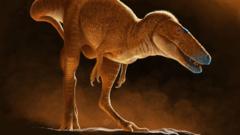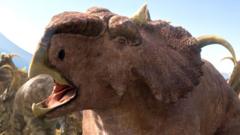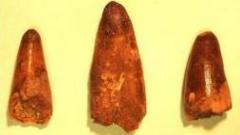The discovery of a new dinosaur species in Mongolia suggests a significant evolutionary shift among tyrannosaurs, ultimately shedding light on their dominance in prehistoric ecosystems.
**New Dinosaur Species Found: A Game Changer in Tyrannosaur Evolution**

**New Dinosaur Species Found: A Game Changer in Tyrannosaur Evolution**
Researchers unveil Khankhuuluu mongoliensis, promising to transform the understanding of T.rex's lineage.
Researchers have made a groundbreaking revelation in paleontology with the identification of a new dinosaur species that challenges existing knowledge of the evolutionary lineage of tyrannosaurs. The newly named Khankhuuluu mongoliensis, or Dragon Prince of Mongolia, was discovered among skeletons at a Mongolian museum, dating back 86 million years. This species stands as the closest known ancestor to the formidable group of predators that includes the legendary T.rex.
The research team, led by Prof. Darla Zelenitsky from the University of Calgary, published their findings in the esteemed journal Nature. They emphasize that Khankhuuluu represents a crucial evolutionary link, showcasing the transformation from small, agile carnivores to the powerful giants that would eventually dominate the ecosystems of North America and Asia until the mass extinction event that ended the reign of the dinosaurs.
“A term we use is 'Prince' as this represents an earlier, smaller lineage of tyrannosauroids,” explained Prof. Zelenitsky. The initial ancestors of this group were diminutive in stature and agile hunters, living in the shadow of larger predators. The discovery of Khankhuuluu reflects a transitional phase in the evolution of these dinosaurs, leading to formidable species like the T.rex.
With an estimated weight of about 750 kilograms, Khankhuuluu was significantly lighter than an adult T.rex, which could weigh up to eight times more. This discovery not only redefines the tyrannosaur family tree but also highlights the evolutionary features that equipped these predators with increasingly powerful jaws capable of exerting immense bite forces.
“The nasal structures in this species reveal early developments that would eventually lead to the powerful bites seen in later tyrannosaurs,” noted Jared Voris, the PhD student leading the study. Such adaptations would enable T.rex to tackle larger prey, occasionally even crunching bone.
These two partial skeletons were initially discovered in the early 1970s and were previously misclassified as Alectrosaurus. Upon closer examination, Voris identified distinctive features linking them to tyrannosaurs. Their unique anatomical traits provide insight into the evolutionary journey of tyrannosaurs as they adapted to various environments on what were once connected landmasses.
According to Voris, the trade of species across continents, facilitated by land bridges connecting Siberia to Alaska, greatly influenced the evolution of tyrannosaurs. The discovery of Khankhuuluu underlines a pivotal moment in the lineage of these prehistoric giants, as Prof. Zelenitsky aptly summarized, “Before they became kings, tyrannosaurs were, in fact, princes.”
The research team, led by Prof. Darla Zelenitsky from the University of Calgary, published their findings in the esteemed journal Nature. They emphasize that Khankhuuluu represents a crucial evolutionary link, showcasing the transformation from small, agile carnivores to the powerful giants that would eventually dominate the ecosystems of North America and Asia until the mass extinction event that ended the reign of the dinosaurs.
“A term we use is 'Prince' as this represents an earlier, smaller lineage of tyrannosauroids,” explained Prof. Zelenitsky. The initial ancestors of this group were diminutive in stature and agile hunters, living in the shadow of larger predators. The discovery of Khankhuuluu reflects a transitional phase in the evolution of these dinosaurs, leading to formidable species like the T.rex.
With an estimated weight of about 750 kilograms, Khankhuuluu was significantly lighter than an adult T.rex, which could weigh up to eight times more. This discovery not only redefines the tyrannosaur family tree but also highlights the evolutionary features that equipped these predators with increasingly powerful jaws capable of exerting immense bite forces.
“The nasal structures in this species reveal early developments that would eventually lead to the powerful bites seen in later tyrannosaurs,” noted Jared Voris, the PhD student leading the study. Such adaptations would enable T.rex to tackle larger prey, occasionally even crunching bone.
These two partial skeletons were initially discovered in the early 1970s and were previously misclassified as Alectrosaurus. Upon closer examination, Voris identified distinctive features linking them to tyrannosaurs. Their unique anatomical traits provide insight into the evolutionary journey of tyrannosaurs as they adapted to various environments on what were once connected landmasses.
According to Voris, the trade of species across continents, facilitated by land bridges connecting Siberia to Alaska, greatly influenced the evolution of tyrannosaurs. The discovery of Khankhuuluu underlines a pivotal moment in the lineage of these prehistoric giants, as Prof. Zelenitsky aptly summarized, “Before they became kings, tyrannosaurs were, in fact, princes.”









